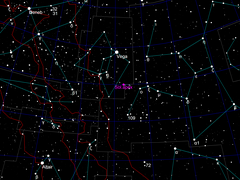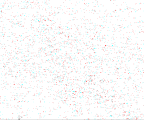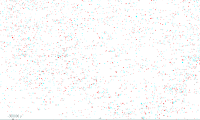Solar apex
| Solar apex |
|---|
 (RA) 18h 28m 0s (dec) 30°N |
| Solar antapex |
 (RA) 6h 28m 0s (dec) 30°S |

The solar apex, or the apex of the Sun's way, refers to the direction that the Sun travels with respect to the local standard of rest. This is not to be confused with the Sun's apparent motion through all constellations of the zodiac, which is an illusion caused by the orbit of the Earth.
Direction
[edit]The solar apex is in the constellation of Hercules near the star Vega[1]
For more than 30 years before 1986 the speed of the Sun towards the solar apex was taken to be about 20 km/s[2] but all later studies give a smaller component in the vector toward galactic longitude 90°, reducing overall speed to about 13.4 km/s.[3] This speed is not to be confused with the orbital speed of the Sun around the Galactic Center, which is about 220 km/s and is included in the movement of the Local standard of rest. Thus the Sun moves towards the apex (a relatively local point) at about 1⁄13 our spiral arm's orbital speed. The Sun's motion in the Milky Way is not confined to the galactic plane; it also shifts ("bobs") up and down with respect to the plane over millions of years.[4]
History
[edit]The nature and extent of the solar motion was first demonstrated by William Herschel in 1783, who also first determined the direction for the solar apex, as Lambda Herculis, 10° away from today's accepted position.[5][6][7]
Many calculations of the solar apex have been published as new catalogues of stars were published.[8] The catalog from the Hipparcos astrometric satellite and measurements with objective prisms lead to a new set of values.[9] These two results do not agree. The calculation of the local standard of rest itself is subject issues due to inhomogeneous stellar velocities[10] and high sensitivity to parameters.[11]
Solar antapex
[edit]The solar antapex, the direction opposite of the solar apex, is located near the star Zeta Canis Majoris.[12]
Gallery
[edit]- Animations of star motions around apex and antapex
-
The movement of stars around the apex (left) and antapex (right) in ± 500 000 years. To view this picture you need 3D glasses (red-green or red-blue).
-
The movement of stars around the apex. To view this picture you need 3D glasses (red-green or red-blue).
-
The movement of stars around the antapex. To view this picture you need 3D glasses (red-green or red-blue).
-
The movement of stars between apex and antapex. To view this picture you need 3D glasses (red-green or red-blue).
See also
[edit]- Manuel Foster Observatory – southern observatory established for the determination of the Solar Apex by W. W. Campbell
References
[edit]- ^ Raymo, Chet (1990). Three Hundred and Sixty Five Starry Nights: An Introduction to Astronomy for Every Night of the Year. Touchstone. ISBN 9780671766061.
- ^ Kerr, Frank J.; Lynden-Bell, Donald (August 1986). "Review of Galactic Constants". Monthly Notices of the Royal Astronomical Society. 221 (4): 1023–1038. Bibcode:1986MNRAS.221.1023K. doi:10.1093/mnras/221.4.1023. See also Table 3 on page 13 of Kogut, A.; et al. (1993). "Dipole Anisotropy in the COBE Differential Microwave Radiometers First-Year Sky Maps". Astrophysical Journal. 419: 1. arXiv:astro-ph/9312056. Bibcode:1993ApJ...419....1K. doi:10.1086/173453. S2CID 209835274.
- ^ U, V, and W (vectors) are c. 10.0, 5.25 and 7.17 km/s respectively, Dehnen, Walter; Binney, James J. (1998). "Local Stellar Kinematics from Hipparcos Data". Monthly Notices of the Royal Astronomical Society. 298 (2): 387–394. arXiv:astro-ph/9710077. Bibcode:1998MNRAS.298..387D. doi:10.1046/j.1365-8711.1998.01600.x. S2CID 15936627.
- ^ Frisch, Priscilla (2000). "The Galactic Environment of the Sun". American Scientist. Vol. 88, no. 1. p. 52. Archived from the original on 24 November 2007.
- ^ Lankford, John (1997). History of Astronomy: An Encyclopedia. Garland Encyclopedias in the History of Science. Vol. 1. Taylor & Francis. p. 258. ISBN 0-8153-0322-X.
- ^ Herschel, William (1783). "On the Proper Motion of the Sun and Solar System; With an Account of Several Changes That Have Happened among the Fixed Stars since the Time of Mr. Flamstead [sic]". Philosophical Transactions of the Royal Society of London. 73: 247–83. doi:10.1098/rstl.1783.0017. JSTOR 106492. S2CID 186213288.
- ^ Hoskin, Michael (1980), "Herschel's Determination of the Solar Apex", Journal for the History of Astronomy, 11 (3): 153–163, Bibcode:1980JHA....11..153H, doi:10.1177/002182868001100301, S2CID 115478560.
- ^ Walkey, O. R. (1 August 1946). "An Abstract on the Solar Apex". Monthly Notices of the Royal Astronomical Society. 106 (4): 274–279. doi:10.1093/mnras/106.4.274. ISSN 0035-8711.
- ^ Fehrenbach, Ch.; Duflot, M.; Burnage, R. (April 2001). "New determination of the solar apex". Astronomy & Astrophysics. 369 (1): 65–73. Bibcode:2001A&A...369...65F. doi:10.1051/0004-6361:20010100. ISSN 0004-6361.
- ^ Francis, Charles; Anderson, Erik (1 October 2009). "Calculation of the local standard of rest from 20 574 local stars in the New Hipparcos Reduction with known radial velocities". New Astronomy. 14 (7): 615–629. arXiv:0812.4032. Bibcode:2009NewA...14..615F. doi:10.1016/j.newast.2009.03.004. ISSN 1384-1076.
- ^ Bobylev, V. V.; Bajkova, A. T. (21 April 2014). "The local standard of rest from data on young objects with account for the Galactic spiral density wave". Monthly Notices of the Royal Astronomical Society. 441 (1): 142–149. arXiv:1404.6987. doi:10.1093/mnras/stu563. ISSN 1365-2966.
- ^ "Furud". stars.astro.illinois.edu. Retrieved 26 May 2024.
Text is available under the CC BY-SA 4.0 license; additional terms may apply.
Images, videos and audio are available under their respective licenses.




